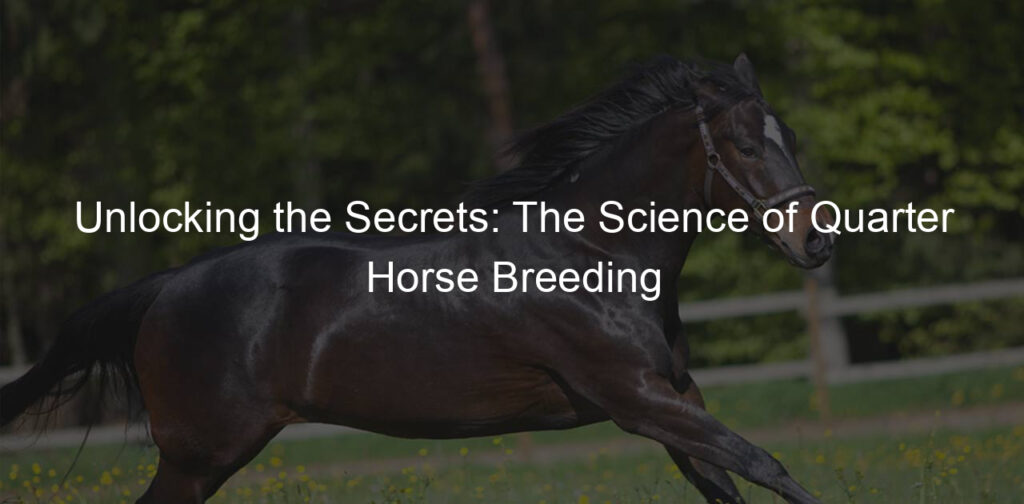Introduction to Quarter Horse Breeding Techniques
Hey there, horse lovers! Today, we’re going to dive into the fascinating world of Quarter Horse breeding. It’s a topic that’s as exciting as it is important, especially if you’re keen on understanding more about these amazing creatures. So, saddle up and let’s get started!
-
Understanding the basics of horse breeding
First things first, let’s talk about the basics of horse breeding. Breeding horses isn’t just about pairing a male and a female together. It’s a complex process that requires careful planning, knowledge about genetics, and a deep understanding of the horses themselves.
When breeders choose to mate two horses, they’re looking at a lot of factors. These can include the horses’ health, their age, and their lineage. They’re also considering what traits they want to pass on to the next generation. This could be anything from speed and strength to a gentle temperament or a particular color.
It’s a bit like putting together a puzzle, where the pieces are all the different traits that make up a horse. The goal is to create a foal that has the best possible combination of these traits. And that’s where specific breeding techniques come into play.
-
Specific techniques used in Quarter Horse breeding
Now, let’s talk about Quarter Horse breeding in particular. Quarter Horses are known for their speed, especially over short distances. They’re also incredibly versatile, being used for everything from rodeo events to trail riding and even therapeutic riding programs.
One technique that’s often used in Quarter Horse breeding is called “line breeding.” This involves breeding horses that share a common ancestor. The idea is to preserve and strengthen certain desirable traits. But it’s a delicate balance – breeders need to avoid mating horses that are too closely related, as this can lead to health problems in the foals.
Another technique is “outcrossing,” where a Quarter Horse is bred with a horse from a different breed. This can introduce new traits and increase genetic diversity. It’s a bit like adding new pieces to our puzzle, creating even more possibilities for the next generation of Quarter Horses.
So there you have it, a quick introduction to the world of Quarter Horse breeding. It’s a fascinating topic, and there’s always more to learn. So stay tuned for our next post, where we’ll delve even deeper into the science of horse breeding. Until then, happy trails!
The Science of Horse Breeding
Let’s dive into the fascinating world of horse breeding, specifically focusing on the beautiful Quarter Horse. We’ll explore how science plays a crucial role in this process.
Understanding Quarter Horse Genetics
When it comes to breeding Quarter Horses, genetics is a key player. But what exactly does that mean? Let’s break it down.
- Role of genetics in horse breeding: Genetics is like a blueprint for every living creature. It determines everything from a horse’s color to its height, and even its behavior. In horse breeding, understanding genetics can help breeders predict what traits a foal might inherit from its parents. For example, if both parents are tall, there’s a good chance the foal will be tall too!
- Specific genetic traits of Quarter Horses: Quarter Horses are known for their muscular build, compact body, and amazing speed over short distances. These traits are all determined by their genes. Some specific genetic traits of Quarter Horses include a broad chest, powerful hindquarters, and a calm, easy-going temperament. These traits make them perfect for tasks like cattle herding and rodeo events.
So, the next time you see a Quarter Horse, remember there’s a whole lot of science behind that beautiful creature!
Horse Breeding Biology
Hey there, horse lovers! Let’s dive into the fascinating world of horse breeding biology. We’ll learn about the reproductive system of horses and how biology impacts breeding practices. So, saddle up and let’s get started!
- Understanding the reproductive system of horses
- How biology impacts breeding practices
First things first, let’s talk about the horse’s reproductive system. Just like us humans, horses have their unique reproductive systems. The male horse, or stallion, has two testes for producing sperm. The female horse, or mare, has two ovaries that produce eggs or ova. When a stallion and a mare mate, the sperm fertilizes the egg, leading to the creation of a new life. Isn’t that amazing?
But here’s something even more interesting. Did you know that a mare can only have one foal per year? That’s because the gestation period (the time it takes for the baby horse to develop inside the mare) is about 11 months. Now, that’s a long time, isn’t it?
Now, let’s talk about how biology impacts breeding practices. You see, understanding the biology of horses helps breeders make informed decisions. For example, knowing that a mare can only have one foal per year helps breeders plan their breeding schedules.
Also, breeders need to understand the mare’s estrous cycle (the time when she can get pregnant). This cycle usually lasts about 21 days, but the mare is only fertile for a short period within this cycle. So, breeders need to ensure that the mare and stallion mate at the right time to increase the chances of pregnancy.
Moreover, understanding horse biology can also help breeders select the best horses for breeding. For instance, breeders might look for certain physical traits, like speed or strength, that can be passed down to the offspring. So, you see, biology plays a crucial role in horse breeding!
Well, that’s all for now, folks! We hope you enjoyed this little journey into the world of horse breeding biology. Remember, every horse is unique, and understanding their biology can help us take better care of them. So, keep learning and keep loving horses!
Breeding Quarter Horses: A Detailed Guide
When it comes to breeding Quarter Horses, there’s a lot to know. But don’t worry, we’re here to guide you through it. Let’s dive in!
Equine Reproduction Science
First, let’s talk about the science behind horse breeding. This is called equine reproduction science, and it’s pretty cool stuff!
- Role of reproductive science in horse breeding
- Specific reproductive traits of Quarter Horses
Reproductive science plays a big role in horse breeding. It helps us understand how horses reproduce and what we can do to help the process along. For example, we can use science to figure out the best time for a mare to mate with a stallion. This increases the chances of a successful pregnancy. Pretty neat, huh?
Now, let’s talk about Quarter Horses specifically. These horses have some unique reproductive traits. For one, they tend to be very fertile, which means they’re good at having babies! They also have a shorter gestation period than some other horse breeds. This means that a Quarter Horse mare will be pregnant for about 11 months, while other breeds might be pregnant for up to a year. That’s a whole month less!
So, that’s a quick look at the science behind breeding Quarter Horses. But remember, there’s a lot more to learn. So keep reading, keep learning, and keep loving these amazing animals!
Quarter Horse Pedigree and Lineage
When it comes to breeding Quarter Horses, understanding their pedigree and lineage is crucial. Let’s dive into why this is so important.
- Understanding the importance of pedigree in horse breeding
- How lineage impacts Quarter Horse breeding
Knowing a horse’s pedigree is like having a roadmap to its genetic makeup. It gives breeders an idea of what traits a horse might pass on to its offspring. For example, if a horse comes from a line of fast runners, there’s a good chance it will be fast too. This is why breeders often study pedigrees before deciding which horses to breed. Pedigree charts can help breeders make more informed decisions and predict the traits of future generations.
Lineage plays a significant role in Quarter Horse breeding. The Quarter Horse breed is known for its speed and agility, and these traits are often passed down through generations. Breeders often look for horses with a strong lineage of these traits when selecting breeding pairs. This helps ensure that the offspring will also possess these desirable characteristics. For example, a Quarter Horse with a lineage of successful racehorses would be a prime candidate for breeding.
Understanding pedigree and lineage is a vital part of horse breeding. It helps breeders predict the traits of future generations and select the best breeding pairs. So, next time you see a Quarter Horse, remember that its speed and agility are not just a result of training, but also its pedigree and lineage.
Scientific Horse Breeding: Case Studies
Let’s take a closer look at how science and careful planning can lead to successful Quarter Horse breeding programs. We’ll explore two case studies that highlight both success and the challenges that can arise.
Successful Quarter Horse Breeding Programs
-
Case study 1: A successful Quarter Horse breeding program
The King Ranch in Texas is a shining example of a successful Quarter Horse breeding program. They’ve been breeding Quarter Horses since the 1800s and have produced many champions.
Their success lies in their scientific approach to breeding. They carefully select the best stallions and mares, considering factors like genetics, health, and temperament. They also monitor the mares’ cycles to ensure optimal timing for breeding.
Through this methodical approach, King Ranch has been able to consistently produce high-quality Quarter Horses that excel in various equestrian disciplines.
-
Case study 2: Overcoming challenges in Quarter Horse breeding
Not all breeding programs have smooth sailing. The Three Chimneys Farm in Kentucky faced significant challenges in their Quarter Horse breeding program.
They struggled with issues like low fertility rates and high foal mortality. However, they didn’t give up. They turned to science to help solve their problems.
They implemented a rigorous health screening program for their horses and worked with veterinarians to improve their breeding techniques. They also invested in better nutrition and care for their mares and foals.
Thanks to their perseverance and scientific approach, Three Chimneys Farm was able to overcome their challenges and improve their breeding program significantly.
These case studies show that with careful planning, scientific knowledge, and a bit of perseverance, it’s possible to run a successful Quarter Horse breeding program. Whether you’re just starting out or facing challenges, there’s always a way to improve and succeed.
Conclusion: The Future of Quarter Horse Breeding
As we wrap up our discussion on Quarter Horse breeding, let’s take a peek into the future. What does it hold for our beloved Quarter Horses? Let’s explore current trends and future predictions in horse breeding.
- Current trends in Quarter Horse breeding
- Future predictions for the science of horse breeding
Today, the Quarter Horse breeding industry is seeing a shift towards more sustainable and ethical practices. Breeders are now more focused on the health and well-being of the horses, rather than just their performance abilities. This includes using advanced genetic testing to prevent the breeding of horses with hereditary diseases. Wikipedia provides more details on this.
Looking ahead, the science of horse breeding is set to become even more advanced. Experts predict that technologies like artificial insemination and embryo transfer will become more common, allowing for the preservation of valuable genetics. There’s also the exciting possibility of using gene editing to eliminate certain diseases entirely. However, these technologies must be used responsibly to ensure the welfare of the horses.
So, the future of Quarter Horse breeding looks bright, with a focus on health, welfare, and sustainability. As breeders, it’s our responsibility to embrace these changes and continue to improve the lives of our horses. After all, the future of the Quarter Horse breed is in our hands!









